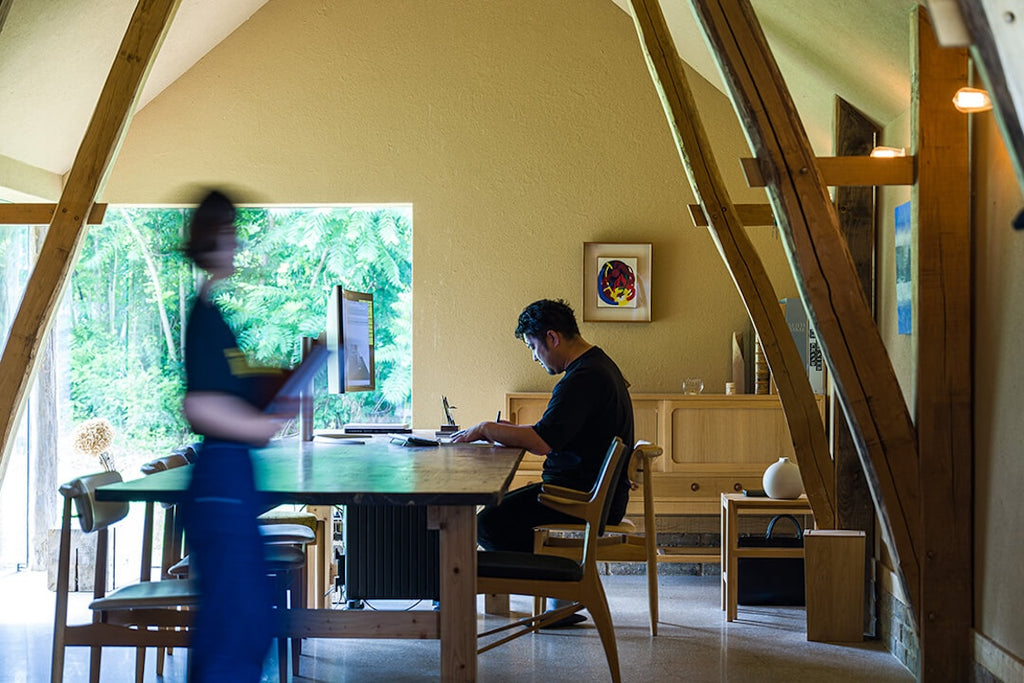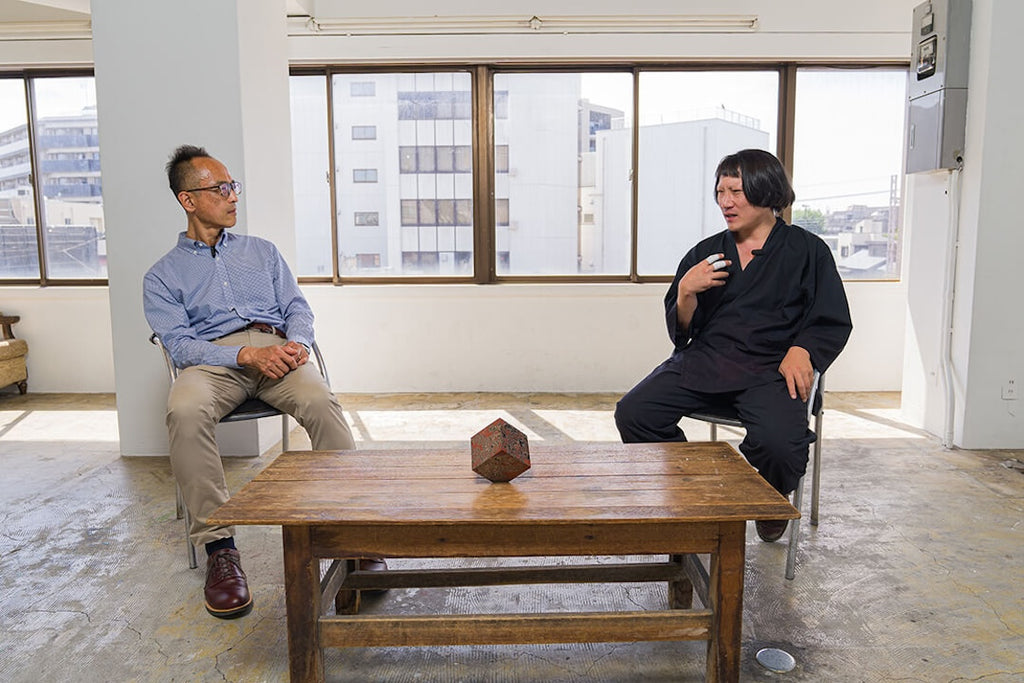ARTICLES
Kazuyuki Futagawa × Meiji Hijikata | The Beauty of Mineral Pigments Resonating on a Silent Landscape
2023.12.08
INTERVIEW

Meiji Hijikata × Kazuyuki Futagawa
This series of articles features conversations between various artists and Meiji Hijikata, Director of the Taro Okamoto Museum of Art, Kawasaki, to look deeper into their artworks. The third installment is a dialogue with Kazuyuki Futagawa, an artist who has been waving his paintbrush in Nihonga (Japanese painting) for many years.
Futagawa's paintings have often depicted nature scenes in a tranquil atmosphere, with faceless people gently blending with the landscape. But in recent years, he has been establishing a new painting style. In this first part of a two-part article, Futagawa talks about his artistic curiosity during his art university years and the growth and conflicts he experienced as a Nihonga artist. Focusing on his landscape paintings, the conversation follows the trajectory and trends of his art and his deep love for mineral pigments.
Sketching the Nature and Seasons of Japan in the Kanazawa College of Art

Futagawa painting "Memory -Lakeside-" in his art studio
Hijikata: You were born in Kagawa Prefecture but moved from Kagawa to study at the Kanazawa College of Art. What kind of instruction did you receive at Kanazawa?
Futagawa: Compared to other art universities, the Kanazawa College of Art emphasizes sketching from nature. I could easily fit in with its atmosphere that follows in the footsteps of the Maruyama-Shijo School of Japanese painting from Kyoto, so I was able to work hard on my sketching without any hesitation.
Hijikata: In the art world back then, I think both Western and Japanese painting were more or less influenced by contemporary art. What was it actually like?
Futagawa: Regarding painting style, most of us respected the traditional way of sketching from nature, creating fairly normal paintings of grasslands, landscapes, or the things around us, so our work was far removed from contemporary art. Our instructor's policy was that contemporary art was somebody else’s business and that we should build our artistic foundations by making sketches using mineral pigments.

Kazuyuki Futagawa "Memory -Autumn Brocade-", 2023, 116.7×90.9 cm, mineral pigment on Japanese paper
Hijikata: Your paintings depict landscapes, and I think that you have a special attachment to nature. Was this an influence of the scenery you saw in Shikoku and Kanazawa?
Futagawa: I have never really thought about it in particular, but I think Japan has one of the richest landscapes in the world to depict as a motif. It stretches geographically from north to south, with pronounced variations in land elevation. It has mountains, rivers, pastures, and coastlines blessed with four distinct seasons and a rich climate. I sometimes paint the landscapes of other countries, but it has always been my belief that the landscape of Japan is the most difficult one to paint.
What is Art? | Artists Living in the Torrent of the Times

Meiji Hijikata × Kazuyuki Futagawa
Hijikata: After graduating from the Kanazawa College of Art, you entered the Tokyo University of the Arts. What is the story behind that?
Futagawa: Ever since I enrolled in the Kanazawa College of Art, I was already thinking about pursuing graduate studies. I spent four years creating art in Kanazawa to go to graduate school. When I got accepted into the Tokyo University of the Arts, I joined the laboratory of Prof. Ikuo Hirayama.
Hijikata: What was it like to fulfill your long-cherished dream of studying at the Tokyo University of the Arts?
Futagawa: During the spring break, before starting my graduate studies, I got to read Taro Okamoto's book called "Today's Art"1, and it left me extremely confused. In the book, Okamoto wrote that art should not be beautiful. The book's contents went completely against my values at the time, but it was written very persuasively, and it led me to stop making paintings in graduate school.
During my time in the Kanazawa College of Art, I was creating paintings without any doubts. Still, after being exposed to a completely different philosophy, I got confused to the point of thinking that simply depicting scenes of nature is meaningless. It took a lot of time for me to break away from Okamoto's ideas [laughs].
Hijikata: That book was a top bestseller back then. During the 1960s, artists like Taro Okamoto strongly advocated ideas and movements such as anti-art that rejected the existing definitions of art. It was also a time when figurative art was being strongly shunned, and many artists from both Japanese and Western painting admitted that they found it hard to paint during the period.
Futagawa: Even the great Nihonga master Kaii Higashiyama created abstract artworks during that period. Ryohei Koiso, a famous realist painter, also created semi-abstract works for his exhibition at the time. Like myself, I think many artists struggled with doubt as they got caught up in the tide of the times.

Installation view of the Kazuyuki Futagawa Solo Exhibition 2023 at the Whitestone Gallery HK H Queen’s 7-8/F
Under the tutelage of Ikuo Hirayama, Futagawa completed his graduate studies, and he began to make a living by teaching painting at several places while continuing to make his own art, even trying out acrylic, tempera, and other materials not normally used in Japanese painting. A few years later, he began a career as an instructor in a public art school.
During his first few years as an instructor, Futagawa could not find much time to paint, but he still made it a point to hold a solo exhibition once a year in order to realize his growth as an artist. Several years later, on the recommendation of his friends that he become a professional artist in his own right, he decided to resign from his job and restart his career as a Nihonga artist, focusing on landscape paintings created with mineral pigments.
The Relationship between Nihonga and Mineral Pigments

A close-up view of Futagawa's painting
Hijikata: When it comes to Nihonga, major exhibitions like the Japan Art Institute's "Inten" and the Japan Fine Arts Exhibition or "Nitten" come to mind. Do you often go to see these exhibitions?
Futagawa: I had not been going for many decades already, but since the past five years or so, I have been visiting them again. Personally, I think the exhibited works have very good motifs, but the mineral pigments are not being used very well. It normally takes around 20 to 30 years for one to master mineral pigments.

Inside Futagawa's art studio
Hijikata: Nihonga artists truly have a special attachment or fondness for mineral pigments, don't they?
Futagawa: Indeed we do. But when I visit Nihonga art exhibitions, I do not see many works that entice other artists to try using mineral pigments. For example, we use green to paint leaves. But this green color must look like the real color of leaves, and the green color must also be beautiful. It has to have both of these qualities at the same time.

Mineral pigments prior to use in Futagawa's art studio
Hijikata: When I listen to your words, I can feel that you have an extraordinary emotional attachment to mineral pigments. What do mineral pigments mean to you?
Futagawa: Mineral pigments are made of extremely rough, coarse particles and are unsuitable for very detailed depictions. For realistic paintings, they are no match for oil paints.
But the mineral pigments of Nihonga are attractive on their own. That is why when I paint, I always consider making the mineral pigments stand out. For example, to show the beauty of the blue-green mineral pigment called "rokusho", I used it to paint the moss in the ancient forest of Yakushima.
I believe that Kaii Higashiyama, Yasushi Sugiyama, Tatsuo Takayama, and other artists in their generation were the first ones to use coarse mineral pigments in painting. Using their unique touches, they were able to leverage the nature of mineral pigments splendidly. Then there was Professor Ikuo Hirayama, who I think was the best painter to bring out the beauty of mineral pigments. On the other hand, I feel that the Nihonga paintings of today are losing sight of this tradition of "showing the beauty of mineral pigments." This is why I always try to fully express the beauty of mineral pigments in my paintings.

Kazuyuki Futagawa "Memory –Mountain Stream-", 2023, 90.9×116.7 cm, mineral pigment on Japanese paper
Through his artistic expressions, Kazuyuki Futagawa sees mineral pigments not just as a painting medium but as beacons of beauty in their own right. His unique artistic style captivates viewers through a brilliant convergence of his love for the diverse landscapes of Japan and his deep passion for mineral pigments. In the second part of the article, he talks about the motifs of his paintings and his latest series of works.
Part.2|Weaving Illusion and Reality into the Coexistence of Nature and Humanity
1Taro Okamoto, Today's Art – Who Will Make History? (Kobunsha, 1954) states that "Today's art should not be good. It should not be beautiful. It should not be comfortable." ▲



